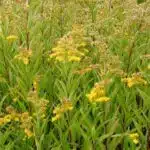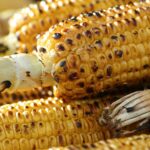Corn smut is a fungal disease that affects maize plants, causing the formation of large galls or tumors on the ears, stalks, and leaves. This plant disease is caused by the fungus Ustilago maydis, which can infect corn plants at any stage of their growth cycle. Corn smut is not only an aesthetic problem for farmers but also has economic implications as it reduces crop yields and can lead to significant losses in revenue.
To combat this plant disease, it is essential to understand how to identify, treat, and prevent corn smut. As a plant pathologist or specialist in plant diseases, it is my responsibility to provide comprehensive information on this topic to support farmers in their efforts to produce healthy crops. In this article, we will delve into the causes of corn smut, its symptoms and signs of infection, effective treatment options available for farmers and preventive measures that can be taken to mitigate its spread.
What Is Corn Smut?
Corn smut, also known as Ustilago maydis, is a fungal disease that affects corn plants. This plant disease is characterized by the formation of large, swollen galls or tumors on the ears, tassels, and other parts of the corn plant. These galls can vary in size and shape but typically have a dark color and are filled with black spores.
The symptoms of corn smut can be devastating to crops as it can cause significant yield losses. Farmers should be aware of these symptoms so that they can quickly identify and manage the disease. Corn smut can be easily distinguished from other diseases such as rusts and leaf spots because of its unique appearance.
Management and prevention strategies for corn smut include planting resistant varieties of corn, crop rotation, sanitation practices, and chemical control measures. Early detection is crucial in preventing the spread of this disease. By implementing these strategies, farmers can reduce the impact of corn smut on their crops, leading to better yields and higher profits. Understanding the causes of corn smut is essential in developing effective management practices for this fungal disease.
Understanding The Causes Of Corn Smut
Corn smut is a fungal disease that affects maize crops worldwide. The fungus responsible for the disease is Ustilago maydis, which infects corn plants at any stage of growth but typically starts at the reproductive stage. The fungus causes galls or tumors to form on infected plant parts such as ears, tassels, and stalks, leading to reduced yield and quality.
The primary cause of corn smut infection is the presence of Ustilago maydis spores in soil or on plant debris from previous crop seasons. The spores can survive in the soil for up to four years, waiting for suitable conditions such as high humidity and warm temperatures to germinate and infect new plants. Other factors that contribute to the spread of the disease include insect vectors such as beetles that transmit spores from one plant to another and poor cultural practices like over-fertilization.
Preventing corn smut infection involves several methods, including planting resistant maize varieties, practicing crop rotation with non-host crops like legumes, managing insect pests using integrated pest management (IPM), and avoiding over-fertilization. Farmers should also ensure proper sanitation by removing infected plant debris after harvest and avoiding the use of contaminated equipment in healthy fields. These prevention methods are critical because once corn smut infects a field, it can be challenging to eradicate it completely without significant yield losses.
As farmers continue to battle against corn smut disease through preventive measures, it’s important to understand the life cycle of Ustilago maydis. Knowing how this pathogen reproduces and spreads can help farmers develop more effective control strategies that target specific stages of its development. In the next section, we’ll take a closer look at the life cycle of Ustilago maydis and explore its various stages in detail.
The Life Cycle Of Ustilago Maydis
According to recent studies, Ustilago maydis, the fungus responsible for corn smut disease, is one of the most economically significant plant pathogens worldwide. The life cycle of U. maydis is complex and involves multiple stages. The fungus overwinters as dormant teliospores in soil or infected plant debris. In spring, the teliospores germinate and produce basidiospores that are dispersed by wind and rain.
The basidiospores infect corn plants through natural openings or wounds on leaves, stems, or ears. Inside the host, the fungus undergoes a series of transformations that lead to gall formation and sporulation. The initial symptom of corn smut infection is a small white or grayish spot on the surface of young kernels or tassels. As the infection progresses, the spot enlarges and becomes a swollen gall that eventually ruptures to release dark brown to black powdery spores.
Understanding the Ustilago maydis life stages and corn smut disease cycle is crucial for developing effective management strategies. By interrupting one or more stages of the disease cycle, it is possible to reduce losses due to corn smut infection. In the following section, we will examine in detail the symptoms of corn smut infection and how to differentiate them from other diseases that affect corn plants.
Symptoms Of Corn Smut Infection
Discoloration of the leaves and husks of the corn plant are one of the first signs of corn smut infection. Swelling of the kernels, often accompanied by blister-like growths, is another common symptom. Decay of the kernels and plant stunting can result from a corn smut infection. Spore release is a key indicator of the presence of the fungus, leading to wilting and vascular discoloration. Fungal hyphae and dark spots may be visible on the surface of the corn plant, as well as canker sores. Finally, defoliation, plant death, and the growth of grayish mold and mushroom-like structures are all signs of a corn smut infection.
Discoloration
When it comes to identifying symptoms of corn smut infection, discoloration is a common sign that maize plants have been affected. Discoloration can occur in various parts of the plant, including the leaves, stem, and kernels. To prevent discoloration caused by corn smut, it is essential to be proactive in managing your maize plants.
Preventing discoloration starts with implementing proper crop management practices. This includes ensuring that your plants receive adequate water and nutrients, as well as maintaining a healthy soil environment. Additionally, planting resistant varieties or using fungicides may help reduce the likelihood of corn smut infection and subsequent discoloration.
If you notice discolored maize plants due to corn smut infection, it is important to take action quickly. Managing discolored plants involves removing infected parts and destroying them to prevent further spread of the disease. It may also be necessary to adjust your crop management practices or seek professional advice from a plant pathologist or specialist.
By understanding the symptoms of corn smut infection and taking steps to prevent and manage discoloration in maize plants, you can help ensure a healthy and productive crop yield. Remember to stay vigilant in monitoring for signs of disease throughout the growing season and seek assistance when necessary for effective management.
Swelling
Corn smut is a fungal disease that can cause significant damage to maize plants. Symptoms of this disease may vary depending on the stage of infection and the location of the affected plant parts. One common symptom associated with corn smut infection is swelling, which can occur in various parts of the plant, including the stem, leaves, and kernels.
Swelling caused by corn smut infection can have a significant impact on plant growth and yield. As the fungal pathogen grows within the plant tissues, it causes cells to enlarge and form galls or tumors, resulting in swollen areas that are often disfigured or malformed. These swollen areas can interfere with normal plant functions such as photosynthesis and nutrient uptake, ultimately leading to reduced crop yield.
Preventing swelling caused by corn smut infection requires implementing effective management strategies. This includes planting resistant varieties, practicing good crop sanitation measures such as removing infected plant parts promptly, and using fungicides when necessary. Early detection of swelling caused by corn smut infection is crucial for preventing further spread of the disease and minimizing its impact on crop yield. Plant pathologists or specialists can assist in identifying symptoms of corn smut infection and providing recommendations for effective management strategies.
Blister-Like Growths
Symptoms of corn smut infection can manifest in various forms, including swelling, discoloration, and blister-like growths. Blister-like growths are a common symptom that may appear on the stem, leaves, or kernels of maize plants. These growths can range in size and shape, and often have a distinct appearance resembling a raised blister filled with dark spores.
The presence of blister-like growths is a cause for concern as they can have a significant impact on crop yield. As the fungal pathogen grows within the plant tissues, it causes cells to enlarge and form galls or tumors. These swollen areas eventually burst open to reveal the black spores of the fungus, which can be easily spread by wind or rain. Preventing the spread of these spores is crucial for minimizing the impact of corn smut infection on crop yield.
Effective management strategies for preventing the spread of corn smut infection include planting resistant varieties, practicing good crop sanitation measures such as removing infected plant parts promptly, and using fungicides when necessary. Early detection of blister-like growths caused by corn smut infection is crucial for preventing further spread of the disease. Plant pathologists or specialists can assist in identifying symptoms of corn smut infection and providing recommendations for effective management strategies to prevent its impact on yield.
Identifying Corn Smut On Maize Plants
Symptoms of Corn Smut infection can vary depending on the stage of the disease. Initially, there may be no visible symptoms, but as the fungus progresses, galls will form on the plant’s leaves, stems, and ears. The galls are typically large and swollen with a grayish-white to black powdery mass inside. This mass is composed of fungal spores that can easily infect other plants.
Differentiating Corn Smut from other plant diseases can be challenging due to similar symptoms. For example, bacterial spot and anthracnose can also cause leaf spots and stem lesions that resemble those of Corn Smut. However, in contrast to Corn Smut, these diseases cause more angular or irregular-shaped spots on the leaves and do not produce galls on the ears.
It is important to take preventive measures to control Corn Smut since it can cause significant economic losses for farmers. Fungicides can help prevent infection; however, they must be applied early in the growing season before symptoms appear. Crop rotation is another effective method for preventing Corn Smut since the fungus cannot survive without its host plant. Additionally, farmers should inspect their crops regularly for signs of disease and promptly remove any infected plant material to prevent further spread.
The Economic Impact Of Corn Smut
Corn smut, also known as Ustilago maydis, is a plant disease that can have significant economic consequences. Corn is one of the world’s most widely cultivated crops, and corn production plays a vital role in many economies. When corn smut infects corn plants, it can cause significant losses to farmers’ yields and profits. This disease has a global prevalence and affects both smallholder and large-scale farmers.
One of the economic impacts of corn smut is the decrease in crop yields. Corn smut can lead to substantial losses in production, which can reduce the supply of corn in the market. This decrease in supply can then lead to an increase in prices for consumers, creating food insecurity for those who rely on corn as their main source of food. Additionally, infected crops often have lower quality than healthy ones, which makes them less desirable for sale or export.
Another economic impact of corn smut is the cost of controlling its spread. Farmers spend considerable amounts on fungicides and other control measures to prevent or manage this disease. These costs are particularly burdensome for smallholder farmers who have limited resources and may not be able to afford such inputs easily.
In summary, corn smut has significant economic consequences worldwide because it reduces crop yields and quality while increasing production costs. It affects both smallholder and large-scale farmers, leading to higher food prices and reduced availability for consumers. Therefore it’s important to identify effective treatment options that can help minimize these economic impacts while maintaining sustainable agriculture practices.
Moving forward into identifying effective treatment options for corn smut, researchers have developed several strategies that have shown promising results against this disease.
Effective Treatment Options For Corn Smut
- Corn smut can be effectively treated using natural remedies, chemical control, and crop rotation.
- Natural remedies, such as neem oil, garlic, and chili peppers, can be used to inhibit the growth of the smut fungus in corn.
- Chemical control can be used to reduce the number of spores and infection levels of the fungus in a cornfield.
- Crop rotation can be used to reduce the number of spores present in a cornfield, as well as reduce the risk of subsequent smut infections.
- Proper identification of corn smut is essential for successful treatment, as the fungus can be mistaken for other diseases.
- Prevention of corn smut is possible through the use of resistant varieties, seed treatments, and cultural practices.
Natural Remedies
Herbal remedies are a popular option for treating corn smut, and there are several that have been found to be effective. One such remedy is garlic, which has natural antifungal properties that can help to slow the growth of the fungus responsible for corn smut. To use garlic as a treatment, simply crush a few cloves and mix them with water to create a paste. Apply this paste directly to the affected areas of the plant, being careful not to damage any healthy tissue in the process.
Another popular home remedy for corn smut is neem oil, which is derived from the seeds of the neem tree. This oil has been shown to have powerful antifungal properties, making it an effective treatment for many different types of plant diseases. To use neem oil as a treatment for corn smut, dilute it with water according to the instructions on the bottle and apply it directly to the affected areas of the plant.
While herbal and home remedies can be effective treatments for corn smut, prevention is always preferable to cure. To prevent this disease from taking hold in your crops, it’s important to practice good sanitation practices in your garden or fields. This includes removing any infected plant material as soon as possible, disposing of it properly, and rotating your crops regularly to avoid planting susceptible plants in the same soil year after year. By taking these simple steps, you can help protect your crops from this destructive disease and ensure a healthy harvest season after season.
Chemical Control
Chemical control is another effective treatment option for corn smut. Fungicides are commonly used to treat fungal diseases in plants and can be an effective way to control corn smut. However, it is important to take precautions when using chemical treatments. Always follow the instructions on the label carefully and wear protective clothing, such as gloves and a mask, when applying fungicides. It’s also important to note that some fungicides can be harmful to beneficial insects and other organisms in the environment, so use them sparingly and only when necessary.
When considering chemical control for corn smut, it’s important to choose a fungicide that is labeled for use on the specific crop you are treating. Some fungicides may be more effective than others for controlling this disease in corn. Additionally, it’s important to note that repeated use of the same fungicide can lead to resistance in the fungus population, making it less effective over time.
While chemical control can be an effective way to treat corn smut, it should always be used as a last resort after other methods have been tried without success. Chemical treatments can have harmful effects on the environment if not used properly or if overused. Therefore, it is essential to weigh the potential benefits against any potential risks before deciding whether or not to use chemical control methods for treating corn smut.
Crop Rotation
Crop rotation is an effective cultural control method for preventing the spread of corn smut. It involves planting different crops in a specific sequence to maintain soil health and reduce the risk of disease buildup. By rotating crops, farmers can disrupt the life cycle of the fungus that causes corn smut and prevent it from establishing itself in the soil. This method also helps to improve soil fertility, reduce nutrient depletion, and increase crop yields.
To implement a successful crop rotation plan for corn smut management, it’s important to consider several factors such as climate, soil type, and crop history. Farmers should avoid planting susceptible crops such as corn in the same field year after year. Instead, they should rotate with non-host crops like legumes or grasses that do not support the growth of corn smut pathogens. Additionally, farmers should practice good sanitation by removing diseased plant debris after harvest to prevent overwintering of the fungus.
In summary, crop rotation is an effective cultural control method for managing corn smut and maintaining soil health. By rotating crops and avoiding monoculture practices, farmers can reduce disease pressure, improve yield potential, and sustainably manage their land resources. Incorporating crop rotation into an integrated pest management strategy can help minimize reliance on chemical inputs while promoting long-term sustainability in agriculture.
Chemical Fungicides For Corn Smut Control
The use of chemical fungicides is one of the most common methods for controlling corn smut. These fungicides are designed to prevent the growth and spread of fungi that cause plant diseases, including Ustilago maydis, which causes corn smut. Chemical fungicides work by inhibiting the enzymes that are required for fungi to grow and reproduce.
However, the use of chemical fungicides can have a significant environmental impact. The chemicals used in these products can leach into groundwater or run off into nearby waterways, potentially contaminating them and harming aquatic life. Additionally, repeated use of chemical fungicides can lead to the development of resistant strains of fungi, making it more difficult to control future outbreaks.
Despite these concerns, chemical fungicides remain an important tool for managing corn smut in some situations. Plant pathologists and disease specialists must carefully weigh the potential benefits and risks associated with their use, taking into account factors such as crop yield, cost-effectiveness, and environmental impact.
Transition: While chemical fungicides offer an effective means of controlling corn smut, they are not the only option available. In the following section, we will explore organic and alternative treatments for this plant disease.
Organic And Alternative Treatments For Corn Smut
Chemical fungicides have been a common method for controlling corn smut. However, with the increasing demand for organic and eco-friendly solutions, more attention has been given to natural remedies for this disease. Organic treatments prove to be as effective as chemical ones, without the potential harm they may cause to the environment.
Organic remedies include cultural practices such as crop rotation, intercropping, and mixed cropping. Crop rotation helps prevent the buildup of smut spores in the soil by planting different crops in succession. Intercropping involves planting two or more crops in proximity, which can deter smut from spreading due to reduced host density. Mixed cropping is a similar approach that involves planting different crops together within the same plot of land.
Other natural solutions include using biocontrol agents such as Trichoderma harzianum and Pseudomonas fluorescens. These beneficial microorganisms can suppress smut growth by colonizing the roots of corn plants and inhibiting pathogen activity. Additionally, foliar applications of plant extracts such as neem oil and garlic extract have shown promising results in reducing smut incidence.
Overall, organic remedies and natural solutions provide effective alternatives to chemical fungicides for treating corn smut. By implementing these methods, farmers can promote sustainable agriculture practices while still achieving successful crop yields.
Transition: While treatments for corn smut are important, preventative measures should also be taken through cultural practices.
Cultural Practices To Prevent Corn Smut
Crop rotation is a cultural practice that can help to prevent the spread of corn smut. It involves rotating corn with other crops to reduce the risk of corn smut development in successive plantings. Crop selection is another cultural practice for preventing corn smut. Varieties that are resistant to corn smut should be selected to reduce the risk of disease. Field sanitation is also important as it helps to reduce the number of spores available for disease development. This includes removing infected plants and debris from the field and avoiding planting in fields that have recently had a history of corn smut infection. Additionally, crop rotation, crop selection and field sanitation should be implemented together for the most effective control of corn smut.
Crop Rotation
Crop rotation is a cultural practice that can help prevent corn smut. It involves planting different crops in the same field each year, rather than growing the same crop every year. This reduces the buildup of disease-causing organisms in the soil and helps maintain soil health. Crop rotation also enhances nutrient availability, improves soil structure, and reduces weed pressure.
To effectively use crop rotation to prevent corn smut, it is important to choose crops that are not susceptible to the disease. For example, planting legumes such as soybeans or alfalfa helps fix nitrogen in the soil and reduce the risk of fungal infections. In contrast, planting corn after corn increases the likelihood of corn smut infection since it allows for spores to build up in the soil over time.
In conclusion, crop rotation is an effective way to prevent corn smut by reducing pathogen buildup and maintaining healthy soils. Planting non-susceptible crops such as legumes can further enhance this approach. By practicing crop rotation and other cultural practices, farmers can prevent corn smut and promote sustainable agriculture for years to come.
Crop Selection
Crop selection is another important cultural practice that plays a significant role in preventing corn smut. One of the most crucial aspects of crop selection is seed selection, which entails choosing high-quality seeds that are not susceptible to corn smut and other fungal infections. Farmers should carefully choose seeds from reliable sources and avoid using seeds from infected plants or those that show signs of disease. Furthermore, farmers should select crops that have a high resistance to corn smut, such as sweet corn varieties that have been specifically bred for disease resistance.
Another critical aspect of crop selection is soil preparation. Farmers must ensure that the soil is well-drained and has optimal nutrient levels before planting their crops. This means conducting soil tests to determine the soil’s pH levels and nutrient content and making any necessary adjustments before planting. Soil preparation also involves removing any debris or plant residues left on the field after harvest, as these can harbor fungal spores and other pathogens.
In conclusion, crop selection is an essential cultural practice in preventing corn smut. By selecting high-quality seeds and preparing the soil properly, farmers can reduce the risk of infection and promote healthy plant growth. Incorporating crop rotation, soil management, and other cultural practices into farming techniques can help prevent corn smut and promote sustainable agriculture practices for years to come.
Field Sanitation
Field maintenance and crop management practices are crucial in preventing the spread of corn smut. Proper field sanitation can significantly reduce the prevalence of fungal spores that cause disease. Farmers should regularly remove any plant debris or residues left on the field after harvest, as these can harbor fungal spores and other pathogens. This practice not only prevents the spread of corn smut but also reduces the risk of other plant diseases.
In addition to removing plant debris, farmers should also practice crop rotation to help prevent corn smut. Crop rotation involves alternating different crops on a field each season to avoid planting the same crop repeatedly in one location. This practice helps break up the life cycle of corn smut and other diseases that affect specific crops. By rotating crops, farmers can also improve soil health and nutrient levels, leading to healthier plants that are less susceptible to disease.
Furthermore, farmers should monitor their fields regularly for signs of disease and take immediate action if necessary. This includes promptly removing infected plants and treating them with fungicides if needed. By practicing good field maintenance and crop management techniques, farmers can prevent the spread of corn smut and ensure that their crops remain healthy throughout the growing season.
Crop Rotation To Control Corn Smut
One effective and practical way to control corn smut is through crop rotation. Crop rotation involves planting different crops in a field over a period of time to maintain soil health and avoid the buildup of pests and diseases. As corn smut is caused by a fungus that can survive in the soil for several years, rotating crops can help break the disease cycle and reduce its occurrence.
To implement crop rotation, farmers need to plan their planting sequence carefully, ensuring that they are not planting similar crops in consecutive years. A good rotation plan should include diverse crops that require different nutrients from the soil, have different growth habits, and are not susceptible to the same diseases. For example, farmers may rotate corn with legumes such as soybeans or alfalfa, which fix nitrogen in the soil and improve its fertility.
Crop rotation offers multiple benefits beyond controlling corn smut. It can enhance soil health by reducing erosion, promoting beneficial microorganisms, and improving water retention. Additionally, it can increase crop yields by supplying adequate nutrients to plants and breaking pest cycles. Therefore, farmers should consider crop rotation as an integral part of their farming system to ensure sustainable production while minimizing disease risks.
| Advantages | Challenges |
|---|---|
| Improves soil health | Requires careful planning |
| Reduces pest pressure | May require additional equipment |
| Enhances biodiversity | Can affect cash flow |
As we have seen, crop rotation is an effective approach to control corn smut while maintaining soil health. However, it requires careful planning and management to achieve desired outcomes. In the next section, we will explore another strategy for managing corn smut: using hybrid and resistant corn varieties.
Hybrid And Resistant Corn Varieties
As corn smut continues to be a significant threat to corn production, plant pathologists and seed developers have been working on developing strategies to control its spread. One such strategy is the use of hybrid research to develop corn varieties that are resistant to the disease. Hybridization involves crossing two different plants’ genetic materials to produce offspring with desirable traits, including resistance to corn smut.
The development of resistant corn varieties has also become a primary focus for many seed companies. The goal is to create seeds that are immune or highly resistant to the smut fungus, making them less susceptible to infections and reducing crop losses. Resistant seed development involves screening of germplasm collections for sources of resistance and then breeding those sources into commercial hybrids.
In addition to hybrid research and resistant seed development, other strategies can help reduce the incidence of corn smut. These include crop rotation, use of fungicides, cultural practices that promote healthy plant growth, and early detection through regular monitoring. By integrating these strategies into an overall management plan for corn production, farmers can significantly reduce their risk of losing crops due to this disease.
Furthermore, as the demand for food production increases globally, it’s crucial that we continue our efforts in developing sustainable solutions against plant diseases like corn smut. The ongoing research on hybridization and resistant seed development offers hope for improved crop yields and food security worldwide by enabling farmers to manage pests effectively without compromising yields or quality. In the next section, we will discuss how early detection and rapid response can further enhance our efforts in preventing damage caused by plant pathogens like corn smut.
Early Detection And Rapid Response
Early detection of corn smut is essential for successful rapid response, and visual inspection is an important part of the monitoring process. Sampling and detection methods can also be used to identify the presence of the disease, as well as effective control strategies for early intervention and timely treatment. Disease management, cleaning, crop resiliency, disinfection, sanitation, and prevention are all important elements of a successful strategy to prevent corn smut.
Early Detection
Corn smut is a fungal disease that affects corn plants, causing significant damage to the crop. Prevention measures are crucial in controlling the spread of this disease, but early detection and rapid response are equally important. Identifying symptoms at an early stage can help prevent further spread of the disease.
One of the most common symptoms of corn smut is the formation of galls on the plant’s ears. These galls start as small bumps and gradually grow into large black masses that resemble mushrooms. Another symptom is the discoloration of leaves, which turns from green to yellowish-brown. The fungus also produces spores that can easily spread to other plants, increasing the chances of infection.
To detect corn smut early on, farmers should conduct regular inspections of their plants. They should look for any signs of galls or discoloration and take immediate action if they find any. This could include removing infected plants or applying fungicides to control the spread of the disease. Early detection helps prevent further contamination and saves crops from being destroyed.
In conclusion, preventing corn smut from affecting corn plants is crucial for farmers’ livelihoods. Early detection plays a vital role in controlling its spread, allowing farmers to take preventative measures before it’s too late. Identifying symptoms such as galls and leaf discoloration can help farmers detect corn smut early on and prevent further damage to their crops.
Rapid Response
Preventive measures are essential in controlling the spread of corn smut, but emergency response is equally vital. Early detection plays a crucial role in providing rapid responses to prevent further damage to crops and reduce the economic losses of farmers. Once corn smut has been detected, immediate action must be taken to contain it.
The first step in an emergency response is isolating infected plants immediately. Infected plants should be removed from the field and destroyed immediately. This will help prevent the spread of spores that can contaminate other plants in the surrounding area. In addition to removing infected plants, farmers can also apply fungicides to control the spread of the disease.
In summary, early detection and rapid response are essential in preventing damage caused by corn smut. Preventive measures such as regular inspections can help detect symptoms early on, while emergency response through isolation and using fungicides can help contain its spread. Implementing both measures together will effectively control its expansion and minimize potential losses for farmers.
Integrated Pest Management For Corn Smut
The cornfield is like a battlefield where farmers wage war against various pests and diseases. Corn smut, in particular, is an enemy that causes significant yield loss, poor quality grain, and reduced marketability of the crop. To win this battle, farmers must employ Integrated Pest Management (IPM) strategies that are sustainable for the environment and economically viable.
IPM strategies for corn smut management involve a combination of cultural practices, biological control agents, resistant varieties, and chemical treatments. Cultural practices such as crop rotation, timely planting, proper irrigation, and sanitation can help reduce the incidence of corn smut. Biological control agents like Trichoderma spp., Bacillus spp., Streptomyces spp., and Pseudomonas spp. have been reported to reduce the severity of corn smut by inducing systemic resistance in plants.
In sustainable agriculture systems, IPM strategies are increasingly becoming popular due to their potential to manage corn smut while minimizing negative impacts on human health and the environment. By using IPM strategies integrated with other management practices such as conservation tillage and cover cropping, farmers can cultivate healthy maize plants that are less susceptible to diseases. As plant pathologists or disease specialists recommend IPM strategies as effective tools for managing corn smut; farmers should adopt these sustainable techniques to combat this foe on their fields.
As we know prevention is better than cure; preventing corn smut in your maize plants is easy if you follow some basic tips.
Tips For Preventing Corn Smut In Your Maize Plants
Preventing corn smut in maize plants is an essential factor in maintaining crop quality and yield. Farmers should employ preventive measures to ensure that their crops are not infected with this disease.
One effective method of preventing corn smut is through crop rotation. This practice involves planting different crops in the same field over time, which helps reduce the buildup of soil-borne diseases. When maize plants are grown continuously in the same field, there is a higher likelihood of disease development due to the accumulation of fungal spores. Crop rotation can break this cycle and reduce the risk of infection.
Companion planting is another useful technique for preventing corn smut. By planting certain plant species alongside maize, farmers can repel or deter pests and pathogens that cause corn smut. For instance, growing marigolds or garlic around maize can help prevent fungal infections as they have natural antifungal properties. Additionally, planting beans alongside maize improves soil fertility by fixing nitrogen from the atmosphere into a form that plants can use for nutrition. These practices work together to create a healthy environment for maize growth while minimizing the risk of corn smut infection.
- Regular crop rotation can prevent fungal buildup
- Companion planting can naturally repel pests and pathogens
- Improved soil health via companion planting also aids in prevention
In conclusion, preventive measures such as crop rotation and companion planting are essential techniques for preventing corn smut in maize plants. By incorporating these practices into farming methods, farmers can lower their dependence on chemical treatments while still protecting their crops from disease outbreaks. Ultimately, these approaches promote healthier plant growth and increase yields while reducing costs associated with disease management.
Conclusion
Corn smut is a plant disease that affects maize plants, causing significant damage to crops and reducing yield. Understanding the causes and life cycle of Ustilago maydis, the fungus responsible for corn smut, is crucial in identifying and treating the disease.
Symptoms of corn smut infection include swollen, distorted kernels on ears of maize plants. Early detection and rapid response are essential for preventing the spread of the disease. Integrated pest management techniques, such as crop rotation and timely application of fungicides, can also help control corn smut.
To prevent corn smut from infecting your maize plants, it is important to use hybrid or resistant corn varieties and practice good sanitation in your growing area. Proper field management techniques and avoiding planting during wet periods can also reduce the risk of infection.
In conclusion, corn smut is a serious plant disease that can cause significant damage to maize crops. By understanding its causes and symptoms, implementing integrated pest management practices, and using resistant varieties of maize plants, farmers can effectively prevent and treat this destructive fungus. As plant pathologists or disease specialists would agree, early detection and prevention are key to protecting our agricultural resources from devastating diseases like corn smut.
Image Credits
- “farm with cornfield near road during daytime” by Julian Schöll (featured)





























